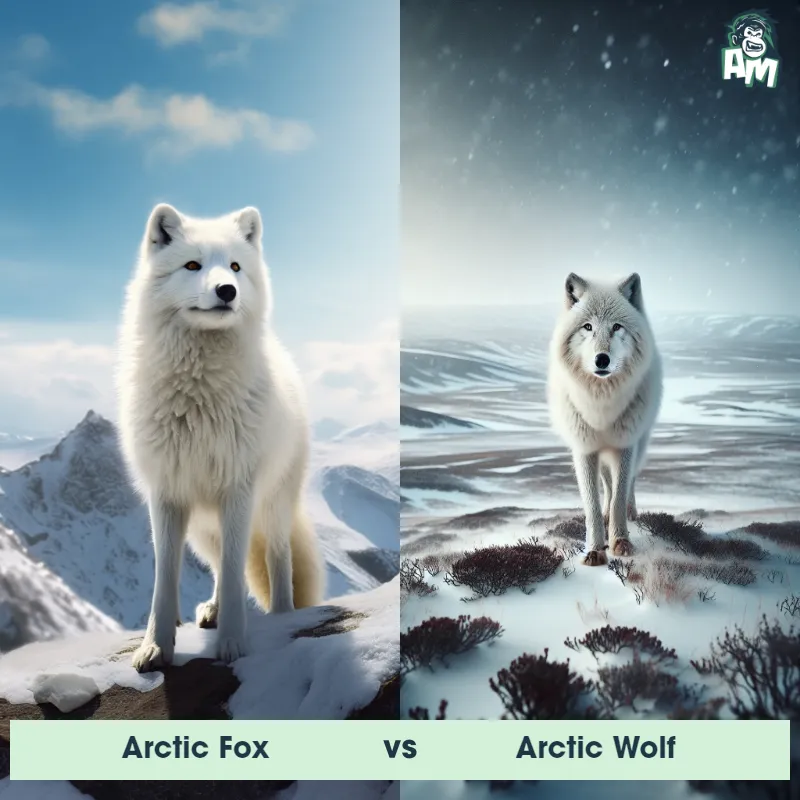Arctic Fox vs Arctic WolfSee Who Wins

Ladies and gentlemen, welcome to this fierce matchup between two of the Arctic's most cunning predators. In one corner, we have the nimble and cunning Arctic Fox, known for its speed and agility. And in the other corner, we have the powerful and majestic Arctic Wolf, feared for its strength and endurance. This three-round battle promises to be a thrilling spectacle of nature's might. Hold on tight, folks, as this showdown is about to begin!
Contender 1: Arctic Fox
The Arctic Fox, also known as the polar fox, is a small fox species that lives in the Arctic regions of the Northern Hemisphere. They have thick white fur that helps them blend in with their snowy surroundings, and they also have small ears and a short snout to help them conserve heat in the cold climate. Arctic Foxes are known for their ability to survive in extreme temperatures, and they are able to dig deep burrows in the snow to stay warm and protected from predators.
Fun Fact: Arctic Foxes have incredibly thick fur, with up to 300 hairs per square inch, which helps them stay warm in temperatures as low as -58°F!
Contender 2: Arctic Wolf
The Arctic Wolf Canis lupus arctos is a subspecies of gray wolf that inhabits the Arctic regions of North America and Greenland. These majestic creatures have adapted to survive in the harsh Arctic environment with their thick white fur, which acts as camouflage in the snowy terrain. They have smaller bodies compared to other wolf species, with an average weight of 75-100 pounds. Arctic wolves are well-known for their incredible ability to endure extreme temperatures as low as -50°C. Their keen sense of hearing and smell, along with their strong, muscular build, makes them highly effective hunters.
Fun Fact: The Arctic Wolf's fur is not actually white, but made up of hollow, transparent hairs that scatter and reflect light, giving them the appearance of being white, and allowing them to blend with the snowy landscape.
Matchup Stats
| Arctic Fox | Arctic Wolf | |
|---|---|---|
| Size | 12-16 inches (30-40 cm) in height, 18-26 inches (45-65 cm) in length | Height: Up to 30 inches (76 cm) / Length: Up to 5 feet (1.5 meters) |
| Weight | 6.5-21 pounds (3-9.5 kg) | 75-100 pounds (34-45 kilograms) |
| Speed | Speed: 25 mph (40 km/hr) | 46mph (74km/h) |
| Key Strength | Agility and speed | Strong bite force and endurance |
| Biggest Weakness | Lack of physical strength | Less aggressive compared to other wolves |
Current Votes
Arctic Fox vs Arctic Wolf
See Who Wins
View More Matches
Looking For More?
Similar Matches
Scientific Stats
| Arctic Fox | Arctic Wolf | |
|---|---|---|
| Scientific Name | Vulpes lagopus | Canis lupus arctos |
| Family | Canidae | Canidae |
| Habitat | Arctic regions of the Northern Hemisphere | Tundra and Arctic regions |
| Geography | Alaska, Canada, Greenland, Russia, Scandinavia | North America and Greenland |
| Diet | Small mammals, birds, fish, and carrion | Carnivorous, mainly preying on musk oxen, Arctic hares, and caribou. |
| Lifespan | 3 years - 6 years | 12 years - 18 years |
Key Differences between Arctic Fox and Arctic Wolf
- Ears: The Arctic Fox has characteristic small, rounded ears that help reduce heat loss, while the Arctic Wolf possesses larger, pointed ears that aid in enhancing their hearing.
- Hunting behavior: The Arctic Fox is an opportunistic scavenger, relying on small mammals, birds, fish, and carrion for sustenance, while the Arctic Wolf is a skilled predator, primarily feeding on large mammals such as muskoxen, caribou, and Arctic hares.
- Size: The Arctic Fox is significantly smaller than the Arctic Wolf, with a maximum length of 3.6 feet and a weight range of 6 to 17 pounds, whereas the Arctic Wolf can reach lengths of 5 to 6.5 feet and weigh up to 175 pounds.
- Color: While both species have adaptations to blend in with their snowy environment, the Arctic Fox possesses a white coat throughout the year, whereas the Arctic Wolf's coat can range from white to light gray or even black.
- Snout shape: The Arctic Fox features a shorter and narrower snout, while the Arctic Wolf has a longer and wider snout, allowing them to capture larger prey.
- Tail: The Arctic Fox has a bushy tail that it uses for balance and warmth, often wrapping it around its body, while the Arctic Wolf has a straight and thick tail that aids in communication and balance.
































